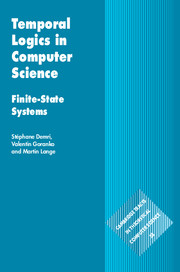9 - Alternating-Time Temporal Logics
from PART II - LOGICS
Published online by Cambridge University Press: 13 October 2016
Summary
The transitions in the transition systems that we have studied so far are primitive and abstract objects. The nature of the possible transitions between states and the mechanisms that generate and determine them have not been essential in the context of the linear and branching time temporal logics we have studied in the previous chapters.
Here we introduce and study a more involved type of transition system, called concurrent game structures, for modelling scenarios that typically arise in open or multiagent systems. An open system is a system (computer, device, agent) interacting with an environment. The properties and behaviour of such open systems can be modelled by 2-player games. More generally, a multiagent system may involve several interacting (possibly, cooperating or competing) agents, each pursuing their own goals or acting randomly (like nature or the environment). Concurrent game structures are special types of multiagent transition systems, where the transitions are determined by tuples of simultaneous actions performed by a fixed set of agents. Various logical formalisms extending linear and branching-time temporal logics can be used for the specification, verification and reasoning about dynamic properties of open and multiagent systems.
In this chapter we present and study concurrent game structures as models for the family of so-called alternating-time temporal logics. They are themost popular and influential logics for strategic reasoning in multiagent systems and are multiagent versions of branchingtime temporal logics which correspond to closed or single-agent systems in a sense that we will discuss in the chapter.
Structure of the chapter. We introduce concurrent multiagent transition systems and models in Section 9.1 and then the logics ATL* and ATL in Section 9.2.We then discuss model checking and satisfiability testing for these logics in Section 9.3. As usual, the chapter ends with exercises and bibliographic notes.
Concurrent Multiagent Transition Systems
Concurrent Game Structures and Models
We begin with a motivating example. Figure 9.1 depicts two transition systems. The one on top involves two robots, Robot1 and Robot2, and a carriage. There are three different positions of the carriage, denoted by states s0, s1 and s2. Each robot has two possible actions at any of the states: push and wait. Robot1 can only push the carriage in clockwise direction, whereas Robot2 can only push it in anticlockwise direction.
- Type
- Chapter
- Information
- Temporal Logics in Computer ScienceFinite-State Systems, pp. 329 - 358Publisher: Cambridge University PressPrint publication year: 2016



